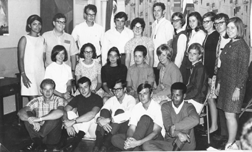 After
33 years of pura vida, GC bids adios to Costa Rica SST, halo and
tenaystgllñ to Cuba, Ethiopia
After
33 years of pura vida, GC bids adios to Costa Rica SST, halo and
tenaystgllñ to Cuba, Ethiopia
By Andrew Clouse and Ryan Miller
The first Study-Service Term in 1968 to Costa Rica was a special
one. Perhaps it was the restless atmosphere of the 1960s. Perhaps
it was the excitement of taking Mennonite ideas about service and
education international. Perhaps it was the excitement of pioneering
a new world. Either way, no one - students, faculty or Costa Rican
host parents - knew what to expect. They could not anticipate the
relationships that were to bloom.
In early August, 33 years after the first SST students arrived in
San José, the final group left the Costa Rican soil carrying
friendships, lessons and memories to last a lifetime.
Exciting beginnings
Hess, professor emeritus of communication, and Henry Weaver, professor
emeritus of chemistry and provost emeritus, explored Panama, Nicaragua
and Costa Rica before selecting the first SST site.
The country's spectacular scenery and friendly hosts impressed the
two. "We quickly found helpers for the program," remembered
Hess. "The people wanted friendship."
In fact, many families who housed students refused payment. Instead,
the college provided many families with a trip to Goshen to experience
life in the U.S. - the opportunity of a lifetime for many Ticos.
Hess, who led a record 13 SST units (all in Costa Rica), said many
Ticos were unfamiliar with the idea of voluntary service. When the
Arenal volcano erupted in 1968, Hess followed "the Mennonite
instinct to go have a service project," and sent the students
to help.
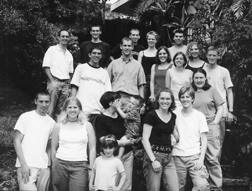 A
time of transformation
A
time of transformation
"Over the years I found that the international experience as
we set it up sooner or later put students into an experience that
required transformation," said Hess. "When students faced
a challenge, that's when they had to dig deep. I have heard so many
stories of the moment of transformation. People say, 'There on SST,
something happened to me.'"
The program not only changed Goshen College, but had an impact on
Costa Rica as well. "(It) opened (the Costa Ricans') eyes to
the world and led to connections in the U.S.," said Wilbur
Birky, director of international education.
Humberto Perez-Pancorbo, a Costa Rican contact and two-time visiting
professor of Spanish at Goshen, said the Goshen contingent and Costa
Ricans shared a similar view on pacifism; Costa Rica is one of the
few countries in the world with no standing military.
A sad farewell
Beth Martin Birky, Goshen College associate professor of English
and director of the general education program, led the final Costa
Rica group with her husband, David, 20 years after experiencing
Costa Rica SST as a student. "We didn't do as many lasts as
we did firsts," she said. "It was pretty easy to draw
new families in and make new connections. ... We're not just regurgitating
an experience."
In the end, Goshen College hosted a dinner for some of the most
influential Costa Ricans over the last 33 years at a San JosŽ
restaurant. The 15 host families of current students also celebrated
with a party. An ad was placed in Costa Rica's largest newspaper,
La Nación, thanking the country for its warm hospitality.
Unlike most SST units, many of the Costa Rican families regularly
housed Goshen College students. Do–a Marta Rodriguez, affectionately
known as "Mrs. Goshen," hosted 47 students; one of her
daughters kept another 30.
Birky said, "Costa Rica, perhaps more than any other country,
owned the program. It was not our program alone - it was their program."
Birky said the college encountered no problems in Costa Rica, but
needed to explore new settings. Martin Birky hopes to continue to
build on Costa Rican relationships, proposing a women's studies
program to study the role women play in the Costa Rican government.
¡Cuba vive! GC taking SST south in 2002
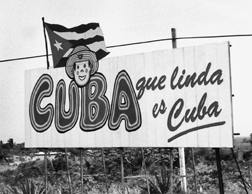
Until
recently, the idea of a Christian college beginning a semester-long
program in Cuba geared around faith, in-depth cultural study and
service seemed highly unlikely, almost ludicrous. Goshen College
will change those perspectives by taking its SST to the Caribbean
island of Castro and Ché beginning May 2002.
The summer 2002 term also marks Goshen's first foray into East Africa,
entering Ethiopia led by Dr. Zenebe Abebe, vice president for multicultural
education, who will be returning to his homeland.
Working through the Cuban Council of Churches, and licensed by the
U.S. Department of Treasury and Cuban Bureau of Religious Affairs,
Carlos Romero, vice president for student life and dean of students,
and his wife, Celina, will lead a select group of 23 students in
the first unit.
Students will spend six weeks studying in Havana through the Martin
Luther King Center of Havana, William Carey Baptist Church and José
Martí Language Center. During the second six weeks, students
will live at the Center for Christian Dialogue and Reflection in
C‡rdenas, Elián González's hometown, and serve
in agricultural, ecological, community development or other service
jobs.
"Many people come to Cuba for short-term learning. Many come
in on work brigades. The Cubans are geared up for that, but they
have not seen the two together," Romero said.
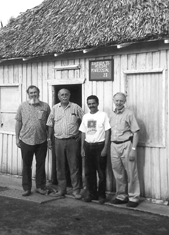
The
Ethiopian unit, announced in March of 2000, takes students to a
developing nation that offers a spectrum of cultural opportunities,
religious history and political lessons. Students will split their
time between studying the Amharic language in Addis Ababa and doing
service in other parts of the country.

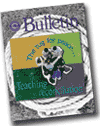

 After
33 years of pura vida, GC bids adios to Costa Rica SST, halo and
tenaystgllñ to Cuba, Ethiopia
After
33 years of pura vida, GC bids adios to Costa Rica SST, halo and
tenaystgllñ to Cuba, Ethiopia A
time of transformation
A
time of transformation Until
recently, the idea of a Christian college beginning a semester-long
program in Cuba geared around faith, in-depth cultural study and
service seemed highly unlikely, almost ludicrous. Goshen College
will change those perspectives by taking its SST to the Caribbean
island of Castro and Ché beginning May 2002.
Until
recently, the idea of a Christian college beginning a semester-long
program in Cuba geared around faith, in-depth cultural study and
service seemed highly unlikely, almost ludicrous. Goshen College
will change those perspectives by taking its SST to the Caribbean
island of Castro and Ché beginning May 2002. The
Ethiopian unit, announced in March of 2000, takes students to a
developing nation that offers a spectrum of cultural opportunities,
religious history and political lessons. Students will split their
time between studying the Amharic language in Addis Ababa and doing
service in other parts of the country.
The
Ethiopian unit, announced in March of 2000, takes students to a
developing nation that offers a spectrum of cultural opportunities,
religious history and political lessons. Students will split their
time between studying the Amharic language in Addis Ababa and doing
service in other parts of the country.